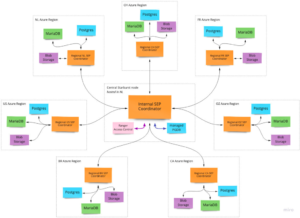
Broadband for all is in the spotlight right now, and closing the digital divide is recognized as a national priority. The divide goes far beyond access and touches issues of costs, ownership, culture, awareness, skills, and more. As we enter into a period of major statewide planning and deployment efforts, incorporating equitable processes and outcomes from the start is crucial to avoid perpetuating continued inequalities in access, adoption, and literacy.
Digital equity is not just a value statement: it’s a commitment to inclusive and equitable decision making at every stage of broadband deployment, from planning to service delivery.
Ensuring equitable representation at the table
Embedding digital equity analysis into mapping is especially critical at this moment in time as we prepare for historic broadband funding. This funding is an opportunity to rebalance systemic patterns of exclusion and ensure rapidly deployed planning and implementation funds are fairly dispersed.

The Digital Equity Act provides $2.75 billion to establish three grant programs that promote digital equity and inclusion, including the State Digital Equity Planning Grant Program, a $60 million grant program for states and territories to develop digital equity plans. In creating these Statewide Digital Equity Plans, extensive outreach to and collaboration with underserved, unserved and historically marginalized populations will prove critical. These discussions will be much more informative and effective in guiding successful policies, programs and projects if they are rooted in clear understanding of social, economic and environmental patterns alongside broadband access maps.
Documenting the effects of digital exclusion
Access is not an equal term: reducing it simply to speed of service available neglects the social and economic complexities that determine how and where users are affected by a lack of broadband. In short, mapping where the infrastructure exists only tells part of the story. Data analysis needs to layer in demographic and economic information in order to reveal patterns of exclusion and identify root causes.
To better understand community impacts, our team at Michael Baker developed data visualization tools such as a Digital Equity Atlas which takes the next step toward analyzing how broadband gaps disproportionately impact segments of the population. The methodology looks at Title VI and Environmental Justice data to reveal where poor connectivity correlates to social factors including low income, senior populations, English as a Second Language, households without a vehicle and more. As an example, the Southwestern Pennsylvania Commission leveraged the Digital Equity Atlas to prioritize new broadband expansion projects that stand to benefit the greatest number of at-risk or marginalized households. These households should not be last in line to see broadband investment finally bringing greater connectivity and opportunities to their doorsteps.
Fulfilling Broadband Equity, Access, and Deployment program requirements
Federal reporting requirements for upcoming Investment in Infrastructure and Jobs Act funding call for a proven and documented understanding and analysis of digital equity needs, from planning to projects in the ground.

The IIJA’s Broadband Equity, Access and Deployment Program provides $42.45 billion to expand broadband access by funding planning, infrastructure deployment and adoption programs across the country. Statewide Five-Year Action Plans, funded through this program, will require government agencies and their partners to take an integrated digital equity approach.
From planning through the ensuing reporting requirements, establishing digital equity strategies and a clear rubric for measuring success in achieving digital equity goals is a must for agencies. These entities must demonstrate how projects funded through BEAD improve digital equity. A strong data-driven baseline – such as the Digital Equity Atlas – will be a necessary starting point for agencies to track and monitor the effect of each new deployment on surrounding households. These data-driven metrics will also be a win for state and local governments to tell the story of their successes with clear data to back it up.
Setting a goal for sustainable inclusivity
As the consumption of internet content continues to rise and as broadband for all projects bring connectivity to the unserved, baseline expectations for broadband service and speed will only continue to grow. If we aren’t careful, new categories of have-nots will emerge: for example, those who pay high fees for minimum speeds versus those with lower fees for premier plans and Gig speeds. The currently unserved will gain access to service, but many will continue to struggle with basic internet skills, navigating through complex terms of service, or even simply finding time to schedule installation without missing a day of work.
To create a truly equitable society, everyone – no matter age, ability, location or status – needs access to affordable and reliable broadband; internet-connected devices; education on digital technology and best use practices; tech support and online resources that help users participate, collaborate and work independently.
By grounding our planning in equitable practices from the very first step, we can help to ensure that everyone is able to benefit from Internet for All.
Kirsten Compitello, AICP, is the National Broadband Digital Equity Director at Michael Baker International. This piece is exclusive to Broadband Breakfast.
Broadband Breakfast accepts commentary from informed observers of the broadband scene. Please send pieces to commentary@breakfast.media. The views expressed in Expert Opinion pieces do not necessarily reflect the views of Broadband Breakfast and Breakfast Media LLC.



